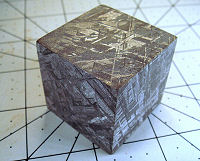|
||
| Primary and Secondary Structures in Meteorites |
 |
| Go to: Table of contents |
| What this site is about, a brief preface: |
| Over the last two hundred years,
meteorites have moved from the dustbins of museum collections to the forefront
of many science disciplines. Prior to the early 1800s, in the earlier days of geology, meteorites were not believed to have fallen from the sky. They were viewed as odd-looking rocks and geologic anomalies that didn't fit into the classification systems of the day. Visually, they didn't glitter with crystal-covered surfaces or have the appearance of an amethyst-lined vug like many minerals held in collections of the day. No, they were primarily dusty, bland rocks in the back of university shelves and drawers. But over time, the curious among us began noticing and studying their interiors. Two hundred years later, they are now understood to contain the chemistry and structures of our origins, which would become our material world today. They are the only unaltered physical evidence that we have from 4.56+ billion years ago. This site and the publication of "Primary and Secondary Structures - Meteorites" use digital, high-resolution imagery, flat field microscopy, and the specimen preparation needed to tease out the finer and often subtle nature of meteoritic structures and inclusions, placing the reader in the center of the topic. It is best viewed on a desktop, laptop, or tablet. Meteorites are not structurally uniform and homogeneous. If they were, we would have great difficulty understanding their history and, in most cases, any altering events over their 4-plus billion-year travels since formation. Primary and secondary meteorite structures are measurable chemical and physical property variations. They are a type of road map followed by igneous and metamorphic petrologists, leading to a consensus on understanding their history. The primary structures are those that develop at the time of formation, i.e., small body chondrule accretion in stone chondrites or, in iron meteorites, the beginning solid state diffusion of Fe and Ni atoms into a distinct alloy during the initial crystallization and cooling when part of its parent body. Secondary structures develop at the end of primary cooling or from the subjection to external forces, such as shock, impact, single or orbital solar heating events, terrestrial weathering effects, etc. A brief note on structures: In Geology, the law or principle of inclusions implies that any rock fragments inside a host rock body are older than the host rock. However, the use of "inclusions" should be constrained more loosely in meteoritics. For example, an inclusion of schreibersite (a phosphide mineral) in an iron meteorite does not predate the parent austenite or taenite. The schreibersite nucleated later towards the end of primary cooling. Similarly, during primary cooling from a melt, the solid-state nucleation of kamacite around foreign particles of silicates, chromite, troilite, and schreibersite results in defined inclusions or, as is sometimes used in publications, "structures." Many people are now interested in meteorites. They have become the central theme in some movies and books and are collectibles. This site, Meteoritestructures.org, is about the science side of meteorites: presenting some of what has been found "in" and "on" them. Fifty of some of the most researched inclusions, structures, and published terms are presented here. The site has put a face on them, identifying them in hi-res images suitable for further publication to supplement research papers and academic lectures. In 1983, Robert Hutchison, the esteemed Curator of Meteorites, at the Natural History Museum, London, UK, wrote a book about meteorites titled "The Search for Our Beginning." The title is profound. Any systematic study of meteorites, at any level, from private collectors to professional meteoriticists, is, in many ways, a search for our beginning. You may agree when you study the images in the following 50 pages. RK All imagery was produced by New England Meteoritical Services using laboratory-prepared specimens held in the NEMS meteorite collection. The imagery is copyright protected, 2024, 2025. The high-res images of all specimens are available in digital form for scholarly publications, lecture series, and educational websites. Please contact us for the customary publishing release and limitations. |
| Contact: Staff@meteoritestructures.org |
| Table of contents |
|
|